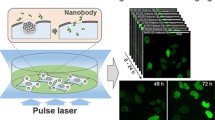Abstract
The potential of a femto-injection technique for use in analyzing protein dynamics in embryonic stem (ES) cells was investigated. First, we showed that fluorescent proteins could be injected in a quantitative fashion into individual mouse ES cells. Second, we demonstrated that the technique could identify functional differences between proteins by analyzing the effect of a nuclear localization signal on the behavior of glutathione S-transferase conjugated to green fluorescent protein. The analysis showed a clear difference in the distribution of the protein when the nuclear localization signal was present. Our results confirm that the non-destructive, quantitative and time controllable aspects of the technique provide considerable advantages for the analysis of protein behavior in living ES cells. To the best of our knowledge, this is the first report of the successful introduction of proteins into living ES cells by an injection technique.



Similar content being viewed by others
References
Chai C, Leong KW (2007) Biomaterials approach to expand and direct differentiation of stem cells. Mol Ther 15:467–480
Chauhan A, Tikoo A, Kapur AK, Singh M (2007) The taming of the cell penetrating domain of the HIV Tat: myths and realities. J Control Release 117:148–162
Evans MJ, Kaufman MH (1981) Establishment in culture of pluripotential cells from mouse embryos. Nature 292:154–156
Fischer-Fantuzzi L, Vesco C (1988) Cell-dependent efficiency of reiterated nuclear signals in a mutant simian virus 40 oncoprotein targeted to the nucleus. Mol Cell Biol 8:5495–5503
Funabashi H, Takatsu M, Saito M, Matsuoka H (2010) Sox2 regulatory region 2 sequence works as a DNA nuclear targeting sequence enhancing the efficiency of an exogenous gene expression in ES cells. Biochem Biophys Res Commun 400:554–558
Giudice A, Trounson A (2008) Genetic modification of human embryonic stem cells for derivation of target cells. Cell Stem Cell 2:422–433
Kalderon D, Roberts BL, Richardson WD, Smith AE (1984) A short amino acid sequence able to specify nuclear location. Cell 39(3 Pt 2):499–509
Lanford RE, Kanda P, Kennedy RC (1986) Induction of nuclear transport with a synthetic peptide homologous to the SV40 T antigen transport signal. Cell 46:575–582
Lerou PH, Daley GQ (2005) Therapeutic potential of embryonic stem cells. Blood Rev 19:321–331
Lyman SK, Guan T, Bednenko J, Wodrich H, Gerace L (2002) Influence of cargo size on Ran and energy requirements for nuclear protein import. J Cell Biol 159:55–67
Martin GR (1981) Isolation of a pluripotent cell line from early mouse embryos cultured in medium conditioned by teratocarcinoma stem cells. Proc Natl Acad Sci USA 78:7634–7638
Matsuoka H, Komazaki T, Mukai Y, Shibusawa M, Akane H, Chaki A, Uetake N, Saito M (2005) High throughput easy microinjection with a single-cell manipulation supporting robot. J Biotechnol 116:185–194
Matsuoka H, Shimoda S, Ozaki M, Mizukami H, Shibusawa M, Yamada Y, Saito M (2007) Semi-quantitative expression and knockdown of a target gene in single-cell mouse embryonic stem cells by high performance microinjection. Biotechnol Lett 29:341–350
Niwa H, Masui S, Chambers I, Smith AG, Miyazaki J (2002) Phenotypic complementation establishes requirements for specific POU domain and generic transactivation function of Oct-3/4 in embryonic stem cells. Mol Cell Biol 22:1526–1536
Rasband WS (1997–2011) ImageJ. U.S. National Institutes of Health, Bethesda. http://imagej.nih.gov/ij/
Yamada Y, Yamaguchi N, Ozaki M, Shinozaki Y, Saito M, Matsuoka H (2008) An instant cell recognition system using a microfabricated coordinate standard chip useful for combinable cell observation with multiple microscopic apparatuses. Microsc Microanal 14:236–242
Yamaguchi K, Inoue M, Goshima N (2011) Efficient protein transduction method using cationic peptides and lipids. J Biomed Biotechnol. doi:10.1155/2011/872065
Acknowledgments
We thank Dr. H. Niwa for the donation of feeder free EB3 cells. This work was partially supported by Grants-in-Aid for Scientific Research form The Ministry of Education, Culture Sports, Science and Technology (MEXT), Japan.
Author information
Authors and Affiliations
Corresponding author
Electronic supplementary material
Below is the link to the electronic supplementary material.
Supplementary material 1 (MPG 1,346 kb)
Supplementary material 2 (MPG 1,150 kb)
Rights and permissions
About this article
Cite this article
Funabashi, H., Sugimoto, Y., Saito, M. et al. A femto-injection technique for dynamic analysis of protein function in living embryonic stem cells. Biotechnol Lett 34, 1257–1262 (2012). https://doi.org/10.1007/s10529-012-0922-7
Received:
Accepted:
Published:
Issue Date:
DOI: https://doi.org/10.1007/s10529-012-0922-7




